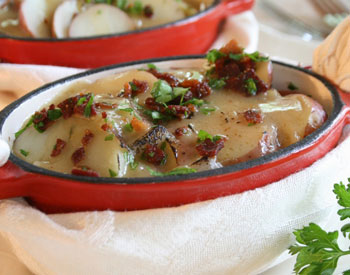 You really don’t need to be German to have fun celebrating Oktoberfest. And, you don’t need to travel to Munich to enjoy the food we associate with Germany and its festival that lasts several days, providing a gateway for summer to turn to fall. This year, the celebrating began September 18 and will run through October 4th.
You really don’t need to be German to have fun celebrating Oktoberfest. And, you don’t need to travel to Munich to enjoy the food we associate with Germany and its festival that lasts several days, providing a gateway for summer to turn to fall. This year, the celebrating began September 18 and will run through October 4th.
My dad was German, so I’ve eaten plenty of roast pork, sauerkraut and huge boiled dumplings that my Hungarian mom became proficient at creating. But when Oktoberfest rolls around, I start thinking about sausage. And sauerkraut. With boiled potatoes. Thick slices of red potatoes blanketed with a smooth, creamy beer-spiked sauce, tender bits of onion swimming through it. I’ve served these potatoes with grilled bratwurst and sauerkraut that’s simmered in beer. It’s delicious.

 Stuffing, mashed potatoes, sweet potato casserole, green bean casserole. Most people will say that Thanksgiving isn't a holiday without these traditional dishes, but that doesn't have to be the case. Although they are classics, it doesn't mean they can't be reinterpreted, reimagined, or replaced with an equally interesting seasonal side dish. When vegetarians are around, it's also courteous to keep them in mind when planning the menu.
Stuffing, mashed potatoes, sweet potato casserole, green bean casserole. Most people will say that Thanksgiving isn't a holiday without these traditional dishes, but that doesn't have to be the case. Although they are classics, it doesn't mean they can't be reinterpreted, reimagined, or replaced with an equally interesting seasonal side dish. When vegetarians are around, it's also courteous to keep them in mind when planning the menu. I've never really gotten into making bread. I do it occasionally, but it's not my passion. When I want to bake something I usually don't have much patience so quick breads are more my style.
I've never really gotten into making bread. I do it occasionally, but it's not my passion. When I want to bake something I usually don't have much patience so quick breads are more my style. What cooking method can be more primal than roasting? When humans discovered fire, it was by roasting over an open pit. Today we simulate this method of indirect cooking in the oven, achieving the best taste by concentrating flavors, retaining interior moisture, and creating a beautiful brown exterior. In gastronomy-speak, this caramelization is known as the Maillard reaction, which is the basic chemical reaction all food undergoes when cooked. But the cavepeople didn't care how sugars reacted with amino acids, all they knew was that fire made things taste good.
What cooking method can be more primal than roasting? When humans discovered fire, it was by roasting over an open pit. Today we simulate this method of indirect cooking in the oven, achieving the best taste by concentrating flavors, retaining interior moisture, and creating a beautiful brown exterior. In gastronomy-speak, this caramelization is known as the Maillard reaction, which is the basic chemical reaction all food undergoes when cooked. But the cavepeople didn't care how sugars reacted with amino acids, all they knew was that fire made things taste good. This is the first time in my life that I won’t be kicking and screaming for summer to stay just a bit longer. Not that I want it to go, mind you, I’m just happy to see the seasons do their thang, the earth to change notches such a tiny bit. The days are already significantly shorter, but when you’re from Southern California you’re generally immune to massive temperature changes anyway.
This is the first time in my life that I won’t be kicking and screaming for summer to stay just a bit longer. Not that I want it to go, mind you, I’m just happy to see the seasons do their thang, the earth to change notches such a tiny bit. The days are already significantly shorter, but when you’re from Southern California you’re generally immune to massive temperature changes anyway.
